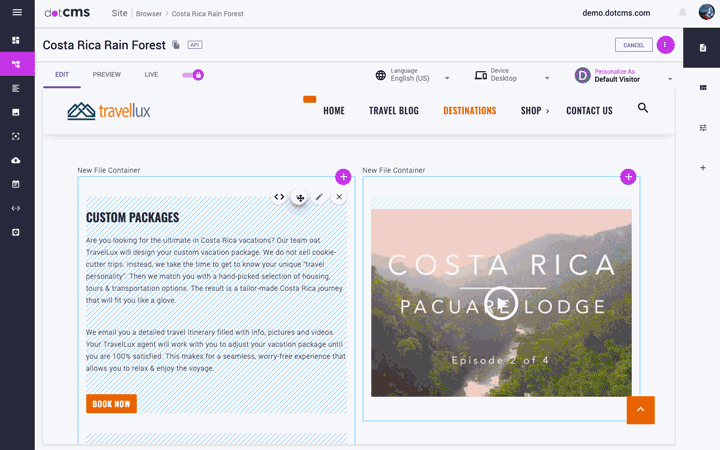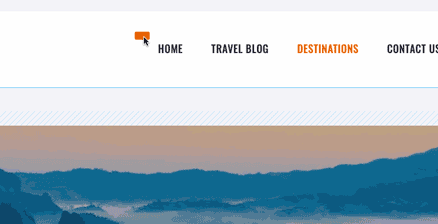The NoCode Platform For Digital Marketing
NoCode — the ability to complete certain tasks (previously complex and developer-heavy) without needing any technical expertise — has been a trend among enterprise software solutions. While a tech startup may have staff that can work with complicated software, many organizations have a sizable number of non-technical employees that need a simple way to work with the software that’s critical for their roles.
That’s why we’re taking an in-depth look at the value of NoCode for the entire organization, and the powerful NoCode capabilities dotCMS provides, when it comes to executing on your Digital Marketing agenda.
Why NoCode Matters
NoCode brings speed and agility to enterprises, improves the overall ROI of the platform, and positively impacts employees across the entire organization.
Non-Technical Staff
For marketers, administrators, and other non-technical staff, NoCode is a game-changer. With NoCode, these users can now operate autonomously without relying on IT staff to get their work done. That means they can execute on their digital ambition faster than ever before, and deliver the customer experiences they want without technical knowledge. NoCode futureproofs the organization.
Technical Staff
But NoCode is always valuable to technical staff as well. By empowering non-technical staff to handle the everyday maintenance of the platform, tech teams can focus on launching new functionality and other high impact tasks. NoCode, therefore, fosters innovation within the organization.
A Deep-Dive Into dotCMS NoCode Capabilities
dotCMS recognized the enormous benefits of NoCode for today’s enterprises and continues to improve upon the platform's NoCode capabilities. Let’s take a closer look at some of the dotCMS NoCode.
Page Template Builder
The template builder enables non-technical users to design the layout of a standard template and choose a theme to determine its look and feel. The template layout itself is made up of any number of containers, and there’s options for adding headers and footers as well. These templates can then be used for any number of web pages without needing front end development knowledge.

Page Editing & Previewing
Using edit mode, the layout and composition of pages can easily be changed using intuitive drag-and-drop capabilities. Any piece of content can also be conveniently edited inline from the same interface.
Once page changes are completed, users can preview their sites for different personas, devices, languages, or other user attributes. That means dotCMS provides truly in-context editing in a headless environment. This capability even works for web apps deployed outside of dotCMS. See Edit Mode Anywhere for more on this.
Navigation Management
Under the links tab in dotCMS, non-technical users can create and manage the links that make up a site’s menu. In addition, all files and folders have a property called “Show on Menu” to automatically display the item within the menu.

Personalization / Rules Engine
Using dotCMS, marketers can deliver personalized content to their audiences using the NoCode personalization and rules engine. Users can define personas just like any other content type, and describe various market segments they wish to target. Marketers can then tag content for a particular persona, and dotCMS will dynamically deliver relevant content based on the persona site visitors are assigned.
Within the rules interface, marketers can create statements that describe the attributes a site visitor may babe, and the action that should be performed if they do. These attributes could be the browser, language, or other similar characteristic of the visitor that the rules engine can easily detect. Some of the default actions include tagging visitors with personas or adding tags. Rules can be created without needing any technical knowledge.
External Data
dotCMS — as a best of breed CMS solution — is highly interoperable with third-party systems. That means its possible to access and utilize external data from directly within the platform’s interface. If organizations have an external digital asset management system (DAM), for example, can make this data available for use from a single interface. dotCMS even supports integration with Widen, Bynder, Nuxeo, and other leading DAM solutions out of the box.
Further Reading: How dotCMS Supports Digital Asset Management
User Management
dotCMS has an enterprise-grade authentication and authorization system based on users, roles, and groups. Users can be created for employees and end-users, and then assigned roles that determine the resources and actions available to them.
Taxonomies & Tag Management
Taxonomies are crucial for content management, but often require an enormous amount of human resources to design and employment. dotCMS streamlines the process by providing intuitive interfaces for managing content types, categories, and tags.
Using these building blocks, organizations can create a content taxonomy that fits their unique business requirements and enables the publishing of highly personalized content at scale.
Read More: dotCMS Taxonomies & Tags: The Key Pillar of Online Conversions
Content Type Builder
The Content Type Builder allows business users to create and manage content types without needing to code. This is critical at the start of a migration project because it allows marketing and IT teams to begin working in parallel to get the platform implemented. The Content Type Builder brings agility to the organization when it comes time to support new channels or digital touchpoints because marketers can maintain control over their content models while developers build out new frontend apps.
Within the Content Type Builder, marketers have a large set of standard fields to choose from. They can even create their own custom fields without requiring additional code. Unfortunately, many other CMS solutions often require scripts or text files to define content models. Content types are critical for building flexible content taxonomies that scale as an organization grows.
Form Builder
Forms are crucial for gathering leads and collecting customer information to fuel a personalization strategy. With the dotCMS Form Builder, marketers can quickly build sophisticated and highly reusable forms without any programming knowledge.
Within dotCMS, forms are another content type that marketers can setup within workflows and collaborate with each other to build. Once built using the intuitive Form Builder, the forms can easily be added to pages using the drag-and-drop visual editor. Most other CMS solutions require involvement from frontend developers to get forms up and running. The Form Builder, therefore, ensures enterprises leverage the enormous amount of customer data at their disposal to gather customer insights and achieve positive business outcomes.
Further Reading: dotCMS Explained: The Revamped dotCMS Form Builder
TimeMachine
There’s also a simple backup and version history tool called TimeMachine. Using this feature, non-technical users can restore previous versions of a site, see a full audit history, or even preview what the site will look like in the future based on the dates content will be published.
With the TimeMachine interface, business users can set up recurring jobs to backup one or more sites and languages on a regular basis. These Snapshots are a full static version of your site that’s fully functional and deployable to servers outside of dotCMS. TimeMachine and Snapshots are critical for compliance and audit purposes at large enterprises.
Read More: Exploring TimeMachine: How dotCMS Handles Content Versioning
Workflow Editor
dotCMS has a robust Workflow Management Module that streamlines the quality control of large-scale content management, and enables marketing teams to reduce the time to market of content.
The Workflow Editor is a NoCode tool for managing dotCMS workflows. Marketers can easily create complex multi-step content approval workflows with a variety of subactions without technical knowledge. Workflows ensure the right users are notified, and that content has approval from four eyes or more. After approval, it’s straightforward to publish individual content or bundles to one or more environments using push publishing.
Further Reading: dotCMS Workflows Explained
Edit Mode Anywhere
Edit Mode Anywhere is a hybrid editing experience for headless frontend apps. Marketers can use the intuitive interface to create and edit content and layouts in-context — even if the app is deployed outside of dotCMS. The innovative editor solves one of the greatest challenges of most headless content management solutions: giving marketers a live preview of the frontend experiences they’re creating content for.
Edit Mode Anywhere features in-line editing, drag-and-drop capabilities, and previews for specific devices. There’s also the ability to preview content as specific personas to fine-tune personalized customer experiences for different market segments. Marketers, therefore, can work with nearly any frontend app and deliver personalized digital experiences without needing to code at all. This differs greatly from most other headless CMS solutions that leave marketers in the dark when it comes to in-context editing.
Read More: Headless CMS for Marketers: Deep Dive into Edit Mode Anywhere
dotCMS: Leading The Charge For NoCode Digital Marketing
We’ve only just scratched the surface of the NoCode capabilities dotCMS provides out of the box. There are additional NoCode features for personalization, digital asset management, managing vanity URLs, and more. That’s not to mention the overwhelming Low Code capabilities for developers and tech-savvy staff as well.
The dotCMS platform allows most marketing teams to handle a wide range of digital marketing tasks without IT intervention to maximize content velocity and platform ROI. dotCMS believes NoCode and LowCode platforms are the future of digital experience management.
Recommended Reading
AI-Powered Engagement: Building Trust Through Technology
The first episode of Real Talk, Real Trust covers AI’s role in building authentic engagement with clients. You can view the episode on YouTube and Spotify now, or read this blog to learn about their c...
Microsoft SharePoint vs dotCMS: A Comprehensive Comparison for Intranet
This blog post will break down the two most popular intranet solutions: SharePoint and dotCMS to help you decide which is best for your company.
Stability and Security: How the WordPress Licensing Dispute is Impacting Enterprise CMS
Recent events in the content management space, including WordPress's licensing disputes, have highlighted the critical need for stability in enterprise CMS platforms.






